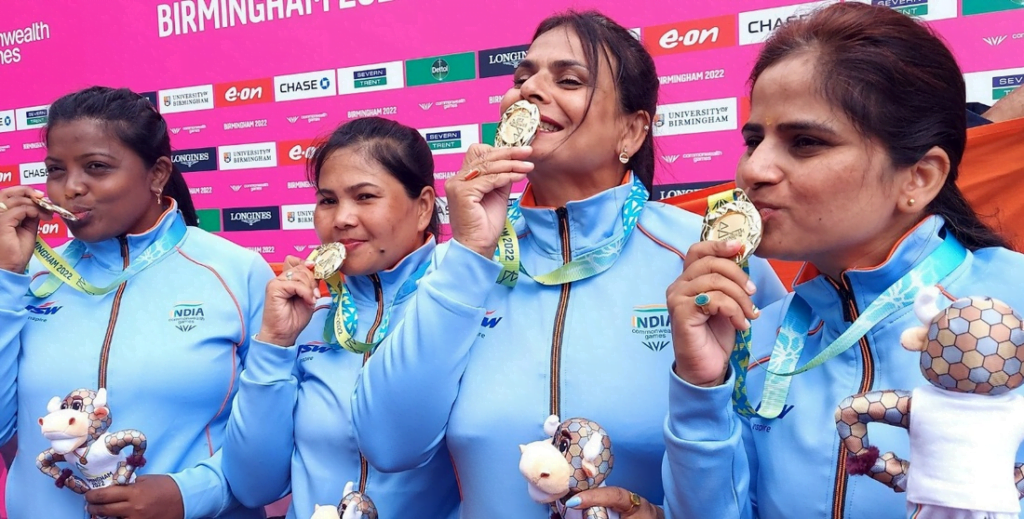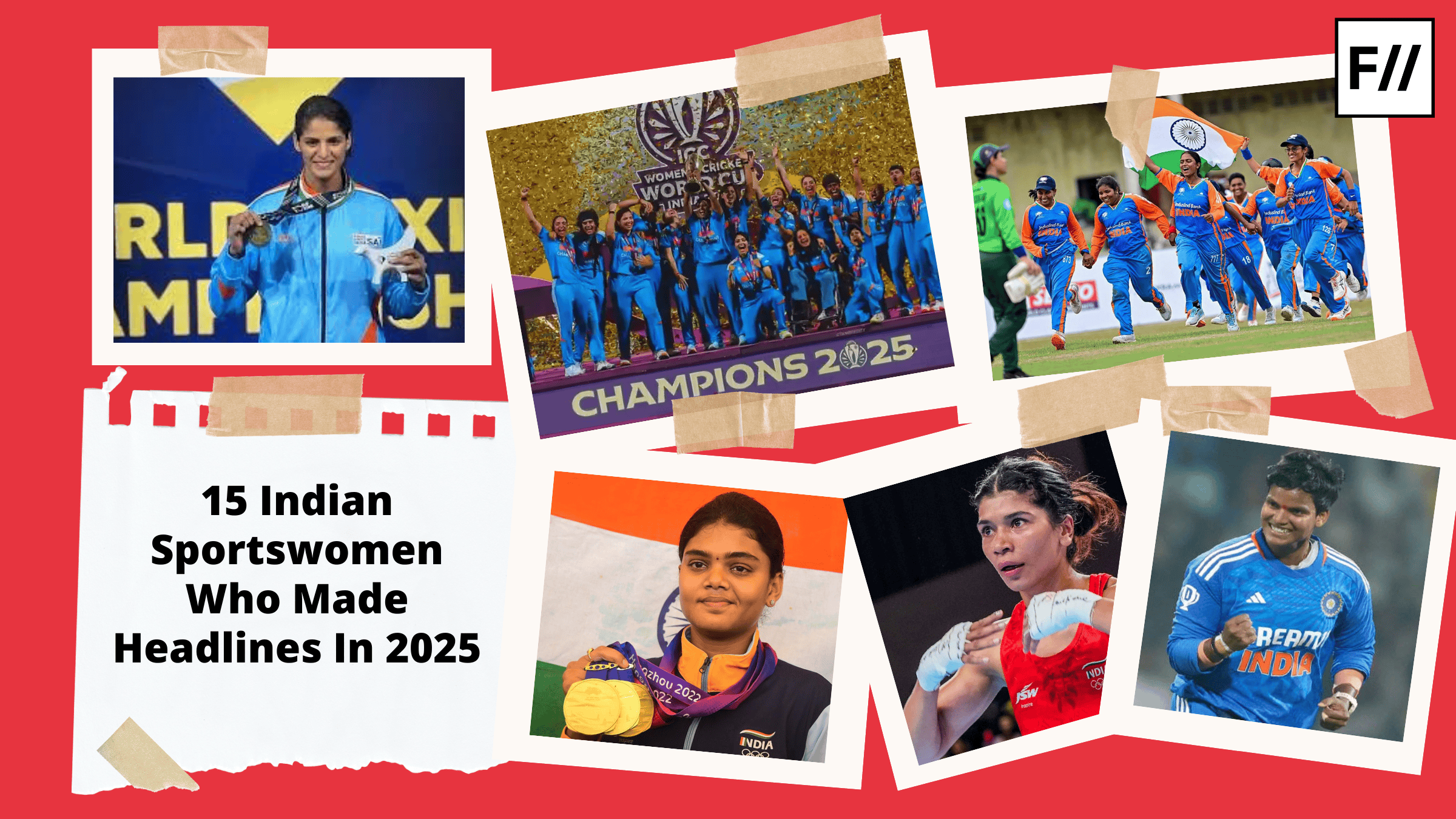India’s women’s lawn bowl team won 61 medals, including 22 gold, 16 silver, and 23 bronze. The team excelled in their sport, made our country proud, and thrived at the 2022 Commonwealth Games. Lovely Choubey, Pinki Singh, Nayanmoni Saikia, and Rupa Rani Tirkey played their best, aimed for the best, and won the Gold in Lawn Bowls.
These four women paved the way for success in an otherwise unknown sport and inspired many girls and the nation’s youth. The players defeated the heavyweights, the South Africans 17-10 in the four final, and their victory was a huge celebration.
Their win is historical and the team is the first to win a gold medal in this sport. This aroused a wave of awe and affection from the public.
Despite this, what did it cost them to win the medal in the first place? At a talk show called Table Talk with Jo, the team shared their struggles with Jyotsna Mohan. It was revealed that the team was very depressed before the games, had close to no support, and feared their careers would end if they didn’t win the medal at the Commonwealth Games.

Women constantly suffer due to the discrimination and injustice they face in sports, whether amateur or professional. From a global perspective, women’s sports are less popular than men’s. The increasing inaccessibility to training, social support, and guidance has constantly left them feeling dejected.
The discrimination manifests in the lack of support structure, difficulty balancing family life and sports, existing gender roles and stereotypes, and inadequate media coverage of women’s sports. Identifying the cultural and social issues is not about men versus women, but the opportunity, safety, and a healthy working environment that every sports person receives regardless of gender.
Sport is a male-dominated field, and through the gradual transformation from a male-only area to an all-inclusive one, women face constant resistance and challenges. Sports organisations, schools, committees, and clubs should impart an inclusive support system to everyone to maintain a sustainable sense of change
While leading and playing sports is essential, women in sports have the right to receive the same treatment as men. There is a need to create an inclusive system where all sports people can thrive. Addressing the dangerous increase in gender imbalance is crucial in developing the sports field.
Reforming the gender imbalance alone is not enough; addressing and correcting cultural barriers in sports organisations is equally necessary to facilitate gender inclusivity in sports.
Also read: Gender Bias In Sports: Women’s Sports Remain Sidelined By Lack Of Investment And Visibility

Lovely, a member of the Lawn Bowls team, opened up about the misogyny and hardships they had to face. The team was told they were selected because of their looks. Lovely, with tears in her eyes, questioned the audience to ask if they won the medal because of their looks.
Almost 40 percent of women have faced discrimination in the sports industry simply because they are women, writes Women in Sport. Women are not deficient in endurance or strength. They simply do not receive the same means and resources to exhibit their capabilities.
The team said that winning the gold medal in this game was their only chance to ignite interest in the sport in the country. Hence, they also had to carry this heavy pressure of expectations, on top of facing harassment.
Rupa Rani Tirkey opened up about their feelings as a team, “We were very depressed. A lot of discussions happened about us. It was very demotivating“. She added that nobody would award a medal based on appearances and that they could succeed.
Even through all the hardships women players go through, they are barely given the opportunity to express their feelings. The four women played various sports, including cricket, kabaddi weightlifting, and athletics, before deciding to hop on the game of lawn bowls. They hoped this new game would open up new avenues for them, so they were excited to play for the country.
Gender stereotypes are a noxious cycle where everyone is affected. Women are left to feel unsafe and unable to nurture their growth, while men are expected to partake exclusively in sports that require a specific body type and are shamed if they participate in sports that are deemed “feminine” (like figure skating and dance
Man’s world: The slow shift from male domination to inclusivity
Sport is a male-dominated field, and through the gradual transformation from a male-only area to an all-inclusive one, women face constant resistance and challenges. Sports organisations, schools, committees, and clubs should impart an inclusive support system to everyone to maintain a sustainable sense of change.
The society perceives male players and women players very differently. Men in sports are regarded as heroes and professionals who ace their field whereas women players are seen as homemakers, mothers, caretakers first, and athletes second.
A man playing with his whole effort is seen as someone who takes sports seriously, but a woman depicting the same passion is disregarded and faced with harsh judgments.
Also read: Male Gaze In Sports: Female Athletes Are Sportspersons, Not Bodies To Be Objectified
Moreover, female athletes are sexualised and objectified for their physique, looks, and behaviour. These toxic stereotypes put female athletes in danger and create an invalidating environment. Officials are more concerned about how these women look rather than the skills they have gained through their efforts.
Gender stereotypes are a noxious cycle where everyone is affected. Women are left to feel unsafe and unable to nurture their growth, while men are expected to partake exclusively in sports that require a specific body type and are shamed if they participate in sports that are deemed “feminine” (like figure skating and dance).
It is crucial to support women’s sports to ensure a safe environment for women players. Supporting female athletes, encouraging them during their games, and appreciating their effort goes a long way. Women are more than how they look and reducing their abilities to their beauty and family roles not only dismisses their personhood but also neglects their skills and ambitions.
Although society is growing to be more inclusive of all genders, races, and sexualities, the prejudice against women athletes continues to be widespread in sports.
About the author(s)
Prathyusha [they/them] is a queer writer from Chennai. When they are not reading, they are either baking or buying books




